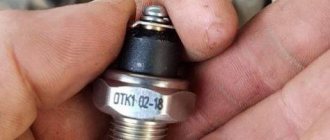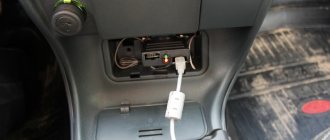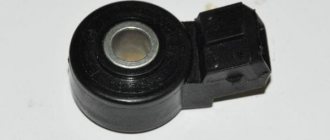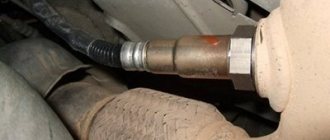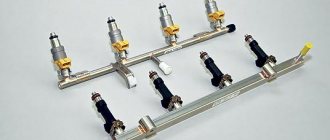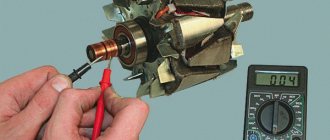Nowadays, scientists strive to provide people with maximum comfort. This applies to all areas of life, and cars are no exception. Thus, to facilitate the operation of this vehicle, sensors and control systems are introduced into the mechanisms, which are responsible for the vital functions of the vehicle. Their main task is to assess the state of certain non-electrical parameters. This assessment is converted into an electrical signal, which tells us about problems. Such an electrical signal can be voltage, frequency and other factors, then this data is converted into an electrical code, which is output to the control unit. One of the most important mechanisms is the knock sensor. If it is faulty, checking the mechanism will not be difficult.
Messages 11
1 Topic by sektor_0986 2014-03-06 09:20:44
- sector_0986
- Experienced
- Inactive
- From: Astana
- Registration: 2014-02-08
- Messages: 327 Thanks : 77
- Car: VAZ-2112
Topic: Resolved: Connecting the knock sensor
Hi all! A colleague went for diagnostics, showed a break in the DD circuit, and they actually looked and it was broken, but it was connected in an unknown way, the only thing left connected was the wire braid, they looked at mine, there the braid was completely cut off, only 2 wires go into the chip! So how should it be, tell me! VAZ 2112 8kl, 2004 without an oxygen sensor, but I have a 2002 and it is there!
2 Reply from Admin 2014-03-06 11:14:47
- Admin
- Administrator
- Inactive
- Registration: 2012-02-20
- Messages: 3,257 Thanks : 624
Re: Resolved: Connecting a knock sensor
3 Reply from igorek 2014-03-06 11:23:24 (2014-03-06 11:25:18 edited by igorek)
- igorek
- Brother-in-law
- Inactive
- From: Bryansk region g Starodub
- Registration: 2013-05-05
- Messages: 416 Thanks : 191
- Car: VAZ-21102 1.5i-8V Bosch MP7.0H
Re: Resolved: Connecting a knock sensor
Admin , as I understand it sektor_0986 means there should be a screen for the knock sensor wire? in the harness to the sensor or not, or simply 2 wires go in a braid, i.e. in a corrugation.
Added: 2014-03-06 12:23:24
sektor_0986 , yes it should be filmed if this is what we are talking about and I understand correctly
4 Reply from sektor_0986 2014-03-06 11:44:17
- sector_0986
- Experienced
- Inactive
- From: Astana
- Registration: 2014-02-08
- Messages: 327 Thanks : 77
- Car: VAZ-2112
Re: Resolved: Connecting a knock sensor
igorek, yes, you are right, I mean the braiding of the dd connection cable, how exactly it should be connected. Like on the link?? It's right. Then why is the braid generally folded back on my car?
5 Reply from igorek 2014-03-06 11:48:50 (2014-03-06 11:59:40 edited by igorek)
- igorek
- Brother-in-law
- Inactive
- From: Bryansk region g Starodub
- Registration: 2013-05-05
- Messages: 416 Thanks : 191
- Car: VAZ-21102 1.5i-8V Bosch MP7.0H
Re: Resolved: Connecting a knock sensor
sektor_0986 , reason unknown. The previous owner probably did something clever, connect everything as it should be!
6 Reply from sektor_0986 2014-03-06 13:13:19
- sector_0986
- Experienced
- Inactive
- From: Astana
- Registration: 2014-02-08
- Messages: 327 Thanks : 77
- Car: VAZ-2112
Re: Resolved: Connecting a knock sensor
So the fact of the matter is that I don’t know how it should be. I tried two schemes and there was no result. how dd should be connected.
7 Reply from igorek 2014-03-06 13:30:43
- igorek
- Brother-in-law
- Inactive
- From: Bryansk region g Starodub
- Registration: 2013-05-05
- Messages: 416 Thanks : 191
- Car: VAZ-21102 1.5i-8V Bosch MP7.0H
Re: Resolved: Connecting a knock sensor
sektor_0986 , as in the diagram it should be, even if you connect everything as possible, you won’t feel any difference due to the fact that it’s a wire screen.
Shielding performs the following functions: - protects against mutual parasitic interference of blocks inside the device - protects these devices from interference from any other devices; - Protects other devices from interference from this device.
Source
The knock sensor has nothing to do with it! Wiring, motherfucker! She's an infection!
Now you will know what it is like to look for something without knowing what.
Well, I'm tired of this problem with the loss of engine speed during acceleration. The car doesn't drive and that's it. And this car is Kalina 1, 8 valves, 2012. The knock sensor error P0327 kept popping up. Open circuit or failure of the DD sensor.
At first, I often climbed under the hood and removed the chip, slightly bent the contacts on the sensor and the error seemed to disappear for a while. Then she appeared again.
But when driving calmly, you practically don’t notice any dips in the engine’s operation. And my driving style is that of a pensioner. On a station wagon you don’t want to stomp on the throttle.
But recently, I very often began to run into the reluctance of my white barrel to accelerate as intended by the manufacturer. And one fine sunny autumn day I went to the store to buy a knock sensor, deciding that it was in it that the problem was hidden, namely in its contact group.
And so the sensor was purchased at the nearest auto parts store for some 165 rubles. It immediately seemed to me that this price was very low for such a part. Even on the Internet the prices were almost twice as high.
Diagnostics with a dial tester or voltmeter
- In addition to a multimeter, you can use a pointer tester - the actions are similar to working with a multimeter.
- There is another way. With the engine idling, connect an AC voltmeter to the sensor. Tap the knock control component with a hard, non-metallic object. If the voltmeter shows that the signal amplitude from the device is below 0.1 V, the device is faulty.
Video on how to check
Knock sensor wire 2110
In any modern automobile engine, continuous fault diagnosis and adjustment of adjustment data are carried out using electronic systems. All VAZ injection engines, including the eight-valve engine on the 2110, are equipped with an engine management system. Each of the important indicators is monitored using a mass of sensors, and the knock sensor is one of them.
Checking parts for one or two wires using a multimeter
The first thing to do is to find out what resistance is typical for a properly functioning sensor in a particular car. The figure varies greatly among different manufacturers.
This is interesting: resistance indicators can be the most unexpected. So, in VAZ cars with injection engines it is almost impossible to measure it because the indicators are too high. In Nissan and Subaru the figures are about 550 kOhm, in Hyundai - about 5 MOhm (megaohm).
To carry out the tests, you will need a multimeter, and a fairly sensitive one, as well as a socket wrench of size “13” or “22”, depending on the size of the installed sensor. To test resistance, switch the tool to kOhm resistance mode and attach it to the probe. If a two-pin sensor is installed in the car, the connection is made to the terminals; in the case of a single-contact model - to the contact and the body.
Now lightly tap the sensor with a metal object - a screwdriver or bolt. Pay attention to the multimeter readings. If there are deviations from the values specified in the instructions, a breakdown has occurred.
It is recommended to check whether there is voltage at the electrical ends. Disconnect the electrical connector of the sensor and remove it from the engine. Switch the multimeter to millivolts and connect the “+” probe to the signal pin. The “—” probe must be connected to the sensor ground. This part is easy to recognize - it is a hole through which the mounting bolt to the motor passes.
Hold the sensor in your palm and lightly tap it on a surface. The result should be a voltage - typically between 30 and 40 mV. If no potential difference occurs, then the sensor has failed.
There are no particular differences in testing for broadband and resonant sensors.
We connect the sensor to the multimeter and knock it on a hard object
Knock sensor VAZ 2110 - purpose of the device
Detonation is a rather unpleasant phenomenon caused by spontaneous uncontrolled combustion of fuel in the combustion chamber.
It can occur due to many reasons - low-quality fuel or inappropriate compression ratio, incorrect operation of spark plugs.
But basically, detonation occurs due to an incorrectly set ignition timing.
A knock sensor will help identify the occurrence of undesirable phenomena in engine operation.
It is in this case that the knock sensor will help to determine the occurrence of an undesirable process at the very initial stage and transmit information about the beginning of detonation to the electronic engine control unit. The ECU, in turn, will adjust the ignition timing automatically to counteract the incipient detonation.
Pros of a working sensor
A working knock sensor will completely relieve the engine from overheating, ensure fuel savings and optimal power and traction.
Operating principle and location
Ignition too early can result in engine overheating, detonation, loss of power and excessive fuel consumption. Too late - the same, but at the same time starting the engine, especially a cold one, is quite difficult.
The piezoelectric knock sensor converts vibrations and noise in the cylinder head into an electrical impulse and transmits this data to the electronic control unit - the greater the one-time pressure on the sensor (micro-explosion, increased vibration), the stronger the signal from it.
The VAZ-2110 is equipped with two types of knock sensors.
There are two types of knock sensors:
- resonant type;
- broadband sensor.
The first type of sensor is configured to oscillate at a certain frequency, it is more accurate and is used on cars manufactured after 2002–2003 . A wideband sensor perceives the entire spectrum of frequencies and its readings are approximate, and the range of the transmitted signal is quite wide.
The two types of sensors are not interchangeable, and before checking and installing a new one, you must know exactly what type of sensor is installed on the engine.
The knock sensor on the VAZ-2112 is located on the front of the engine, next to the oil dipstick.
The sensor is screwed into the cylinder block on the left side under the spark plugs; its replacement and diagnostics take a few minutes.
Types of sensors
The VAZ 2110 is equipped with two types of knock sensors: broadband or resonant. Wideband constantly captures the entire spectrum of noise and also signals about it. After this, the signal is processed and engine operation is adjusted accordingly.
Wideband knock sensor
Resonant ones do the same thing, but their difference is that they give a signal only when the detonation changes. But in fairness, it should be noted that both of these types of devices are very reliable in operation; their malfunctions are the exception rather than the rule, and therefore replacement is not often required.
Resonant knock sensor
The main reason should be sought in the fact that somewhere there is a break in the electrical circuit, after eliminating which the sensor will again give correct readings.
Symptoms of malfunction
You can find out that the meter is not working by a number of the most common symptoms. There is clearly expressed instability in the operation of the motor, jerking is felt, and a sign of tripping appears. The car stops obeying the accelerator pedal, and the dynamics when accelerating drops. After the engine starts, the malfunction indicator light comes on. In such a situation, you should not only check the sensor, but also diagnose other systems. You may need urgent replacement of failed elements. Information about a failure of the meter can be transmitted by the machine's on-board computer.
How to check functionality?
If error code 34 appears on the display, this indicates a sensor malfunction. It is possible to check whether it is still operational or whether it needs immediate replacement. Having completely reset the self-diagnosis results, you need to drive a couple of kilometers and turn on the self-diagnosis system again.
If a new check shows an error again, then replacement is still necessary. If the error is not displayed, then you can still operate the old device. But since code 34 was still displayed earlier, it’s worth checking the connection for a break, that is, carefully inspect the wires, contacts, tighten them, clean them, and you’ll see that replacement won’t be needed.
Errors on the instrument panel display
Considering that the VAZ 2110 can drive for some time without a knock sensor, you can carry out a more thorough check of it, but for this you will have to remove the device.
Measurements
Now you can check with a multimeter set to the minimum value. If the sensor is single-contact, then the negative wire of the multimeter (it is usually black) is connected to the place where the mounting bolt is installed, and the positive wire (usually red) is connected to the signal contact in the connector.
Checking the two-contact sensor is carried out by connecting the multimeter wire to the corresponding contact “-” to “-”, “+” to “+”. Further actions are identical. To activate the sensor, you need to tap it with something not very hard (for example, a screwdriver).
If there are no faults, voltage surges will be observed. Approximately 40 to 200 mV. In addition, it would not hurt to check the internal resistance, which should tend to zero. If you find that the sensor is fine, then look for an open circuit. In this case, the best advice is to replace the entire block with wires.
If the resistance is different, or there are no voltage surges, it means that there is something wrong with the sensor itself and it needs to be replaced. The new one is installed in the reverse order of removal.
Dismantling
First you need to find the sensor. It is located on the left side of the engine, where the line is half of the cylinder block. Next to it is the air filter.
To determine the malfunction or its absence, it is necessary to remove it in the following sequence:
- Disconnect the car from power by removing the negative terminal from the battery;
- Disconnect the block with wires from the contacts of the knock sensor. To do this, press the latch;
- Unscrew the nut securing the device and remove it from the mounting stud.
Please note that during further installation or replacement you will need a torque wrench (tightening force should be 20 Nm).
Repair or replacement?
You decide. The cost of the product depends on the car model and the manufacturer of the component - for a replacement you will need to pay an amount approximately equal to its price. You can change the device yourself; for this you will need a room with a pit. Self-repair is also possible: if you are well versed in cars, it will take no more than an hour.
Checking the knock sensor is an easy task that doesn't require expensive tools. Of course, a computer check at a service station will be more accurate, but if you don’t want to spend money, you can do it yourself.
- Author: Dmitry Buimistrov
Hello! My name is Dmitry, I am a journalist by training. I specialize in automotive topics - I started my career in an online store of automotive components, and I myself am a car enthusiast. Rate this article:
- 5
- 4
- 3
- 2
- 1
(23 votes, average: 3.9 out of 5)
Share with your friends!


